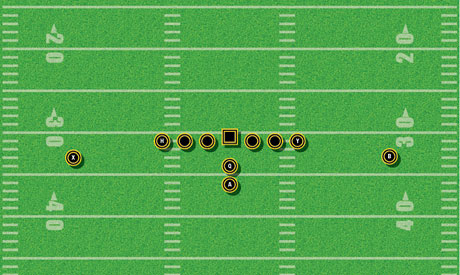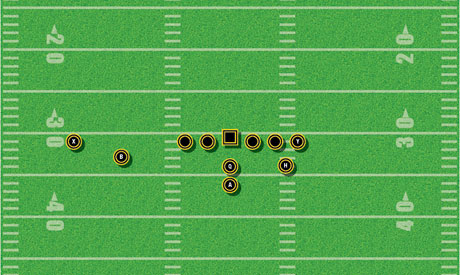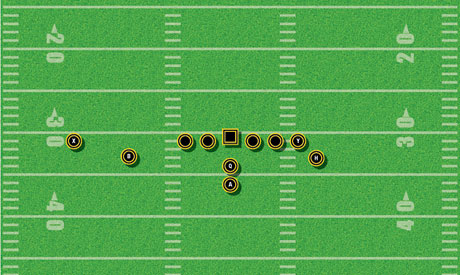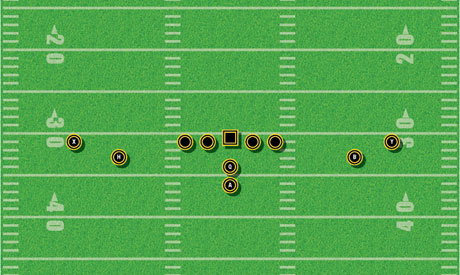AMERICAN FOOTBALL MONTHLY THE #1 RESOURCE FOR FOOTBALL COACHES
Article CategoriesAFM Magazine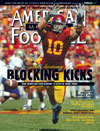
|
The Pistol Offense: Keep the Defense Off Balance by Formation and Tempoby: Steve RampyHead Coach, Blue Valley High School, Stilwell, KS © More from this issue Offensive play callers are constantly looking for an advantage over the defense. One of the ways we try to achieve this is by using many different formations and changing the pace of our offense. We believe we force defenses into playing base fronts and coverages because they can never be comfortable as to what formation we will align; we add to their stress by changing pace of play with no huddle and quick running plays. In this article, we will outline the formations and tempo-changing aspects of our offense. Many Formations with One Personnel Package Many offenses use different personnel packages to change their offensive formations. They run two tight ends on the field to be in an Ace formation or four wide receivers into the game to be in a spread set. They will insert a fullback for all of their two back formations. At Blue Valley, we run our formations with the same personnel package. This means we are looking for very specific personnel to play each offensive position. Offensive ‘Skill’ Positions The X receiver is a true wide receiver type, as he will always align in a wide alignment either on or off the line of scrimmage. His basic alignment is away from the call side, on the line of scrimmage. We would like the B receiver to be the best athlete, capable of playing wide receiver or aligning in the backfield as a running back. We run our fly sweeps with this position. The H receiver must have the highest football IQ. We will align him as an inside WR, a tight end or as a fullback. We would like for him to be physical enough to be a lead blocker but athletic enough to be a good vertical threat. Our tight end (Y receiver) is first and foremost a tight end. He must be able to block inside zone and stretch and counter like the rest of our offensive linemen. We will also flex him as a wide receiver, align him in tandem sets with the H receiver and motion him. Our A back is our primary ball carrier. His basic alignment is one and a half yards behind the QB in a Pistol set. We will also flex him with empty sets; he must have knowledge of route running and secondary coverages. We will align these players in a variety of formations without substituting for them. We will force a defense to align to an Ace formation by lining our H receiver as a tight end (See Diagram 1). We love this formation to run inside zone; power running plays with both the A back and QB; and still be able to throw the ball effectively with four receivers.
We will get into two backs by aligning the H receiver in the backfield in an offset alignment either strong or weak (See Diagram 2). We use this formation for lead plays to the A back or if we need two backs in the protections. We also like this formation for outside running plays like stretch and option. Our H back must also be able to run inside zone and trap. These are his two main running plays.
One of our favorite things to do with H receiver is to align him in tandem with our TE. We believe we get a tremendous advantage in blocking by stretching the front in these unbalanced alignments. In all three, we will either attack the front with stretch, fly-sweep or option if they don’t slide the defense to that side, or attack the weak side if they do. As always, we will run inside zone and power if we feel the front has been stretched to create running lanes. Our Tiger (See Diagram 3) and Tandem (See Diagram 4) provide us with a balanced offense in that we have two receivers to each side but an unbalanced front as we have an extra blocker to one side. Both have been very effective formations in the running and passing game. We feel like the Bunch formation (See Diagram 5) gives us a distinct advantage in the outside running game and combo passing routes.
Our most unique offensive formation is what we term ‘Magnum’ (See Diagram 6). It is a power-I formation with a shotgun mentality. It provides us with great opportunity for lead plays as well as misdirection. But as always, the best thing we do out of it is zone read. The difference for us in zone read out of Magnum is that we always have a pitch back with which to run the option outside. This has been a very effective short yardage offense in the middle of the field.
The last formation we will show here is a spread set. We get to four wide receivers by simply flexing our TE to an inside receiver’s position or we will align him outside as the number one receiver (See Diagram 7). We feel each formation forces a defense to defend a spread scheme with the personnel they have on the field. Quite often this can result in match-ups that are to our favor in both the passing and running game.
While none of these formations in and of themselves cause defenses great concern, we feel that our ability to run all of them with the same personnel does cause defensive stress. We have never aligned our TE as a number one receiver outside without the defense covering him, nor have we ever put an H receiver at TE without a defensive front stretching to align to him. We also believe that these formations put pressure on defenses each week in preparation to be sound in alignment. With all of these factors we feel we force our opponents to play base defensive fronts and coverage against us. It makes it easier for our team to prepare and execute if we know where they’re going to be. Changing Pace of Offense We like to keep a defense off-balance by changing the pace at which we play. We do this in four ways: 1. We will run no huddle off wrist bands, at anytime, but never all the time. We play against teams that are no huddle teams and while this creates some unique challenges for our defense, we become comfortable after a week of practice in playing at a no huddle pace. We feel like it is more a problem for our opponents if, out of nowhere, we get back on the line of scrimmage and run our offense when they least expect us to do it. We don’t hurry; we just don’t huddle. 2. We have ‘Lightning’ and ‘Thunder’ plays, which are three play series that we require our players to memorize. They are plays that we run very well out of our favorite formations. Each series is also printed on the wrist band. If we want to get into one of these series, we simply call a play and end it with ‘Into Lightning.’ That would mean that we get to the line of scrimmage and execute these three plays in a quick, fast-paced tempo. As soon as the referee gets out of the way we want to snap the ball. 3. We run a ‘NASCAR’ series, which is the only time we put our QB under center. We run three plays in NASCAR. They are QB sneak, the stretch play and stretch pass. The difference in NASCAR is that we stay in the huddle together, then sprint to the line of scrimmage together and as quick as possible, snap the ball on the first sound. This puts pressure on the defense to align quickly and be ready to defend each play. 4. The final way we affect pace and tempo is with our ‘quick’ running plays. These plays are inside trap and inside veer. Either play can be run to the fullback or A back, but the tempo of these two plays is much quicker than the rest of our offense. Each one attacks the line of scrimmage down hill and puts immediate pressure on the defense to react much quicker. With each of these components of tempo, surprise may be the most important element. We think they help keep the defense off balance enough to give our offense just the edge it may need to be effective. Changing formations and tempo have been two very important parts of our offensive philosophy over the past few years. These are two effective aspects that can be used with any offense, not just the Pistol. |
|
| HOME |
MAGAZINE |
SUBSCRIBE | ONLINE COLUMNISTS | COACHING VIDEOS |
Copyright 2024, AmericanFootballMonthly.com
All Rights Reserved


